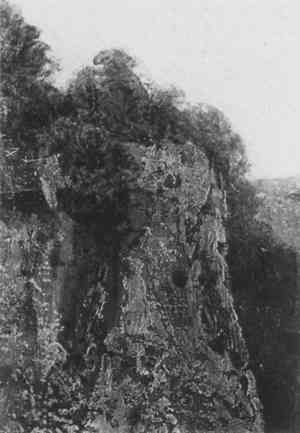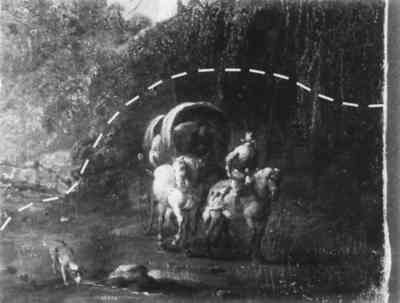AN 18TH-CENTURY ARTIST-APPLIED LINING: JOSEPH WRIGHT OF DERBY'S CUT THROUGH THE ROCK AT CROMFORDIAN S. HODKINSON, & DEBORAH M. CHILD
2 ATTRIBUTION AND PROVENANCEThe Derwent picture is not signed, but during this study a monogram was discovered on the Cromford painting. They both bear the unmistakable stylistic “signature” of Wright of Derby. The choice of palette, the vigorous application of textured paint using both brush The site of the Derwent painting can be identified by the presence of the famous landmark Matlock Tor in the background. Matlock was a popular site for landscape painters and Wright executed a number of paintings of it. They include two scenes of Matlock Tor by moonlight (Matlock Tor, Moonlight, Yale Center for British Art, Paul Mellon Collection [Nicolson 1968, cat. no. 308] and Matlock Tor, Moonlight, Detroit Art Institute [Nicolson 1968, cat. no. 309]; one by daylight (Fitzwilliam Museum, Cambridge [Nicolson 1968, cat. no. 111; see also Egerton 1990, 184]) that has a similar composition to the Queen's University painting; and Landscape with Figures and a Tilted Cart: Matlock High Tor in the Distance (Southampton City Art Gallery Collection; see Egerton 1990, 193), which is taken from almost the same vantage point. The Cromford painting is based on a site in Cromford, Derbyshire, that can still be identified, although the artist has taken some liberties with the topography. The cut through the rock referred to in the title is Scarthin Nick, a massive stone outcropping that occupies the left half of the picture. The view is taken from a vantage point with Cromford Village directly behind. The road in the painting is now the A-6 motorway. Due to the creation of this motorway, the high feature to the right is now less prominent than it appears in the painting. The scene is actually a composite view, and by placing Scarthin Nick in the middle distance rather than the foreground where it should be located, the artist gives the viewer a sense of structure and order typical of the kind of classical landscape composition he practiced. The inclusion of a horse-drawn wagon, two figures, and a dog in the right foreground recalls the naturalistic landscapes of 17th-century Holland. Wright executed at least four other views of the Cromford area. All included horses and wagons, usually with direct reference to Arkwright's Cotton Mills, built between 1771 and 1777, but the wagon type is quite different. The work is inscribed on the back of the stretcher in dark brown ink: Cut Through the Rock at Cromford by Joseph Wright, and an inventory label adhered to the back of the canvas is a complete version of the fragment on Derwent. The label reads: “Dining Room No. 18. A Rockview” and has the initials “C. A.” and “J. G.” (see also fig. 8), referring to the executors of the estate of John Holland (1734–1807), Wright's close friend. According to the Wright files kept in the Derby Art Gallery, this is the painting referred to by Wright in his letter to John Holland: The letter is inscribed on the back in Holland's handwriting: “Received October 10th, 1795 by J. H.” It is in the collection of William Dale of London, Ontario, who acquired it at the same time as he purchased the painting.
Although this inscription provides a terminus date, the style and technique used in painting the landscape suggest an earlier date of 1770–73 when “Wright particularly favoured—a fairly lavish use of paint which is then overlaid with glistening dribbles of impasto, which in its turn is scuffed and scratched to give a lichenous scaly effect” (fig. 5) (Egerton 1990, 75). While this observation is true of the landscape, the same cannot be said for the staffage group at the right (fig. 6). On the contrary, the style and technique are different. In this area the use of paint is much more delicate. It is applied quite thinly
Ultraviolet, infrared, and x-radiography were used to attempt to understand the relationship of the anomalous figure group to the rest of the painting. Unfortunately, these examination techniques provided no clues. Reasoning had to be based on other technical information allied to historical studies. There are several possible reasons for the existence of such a stylistic and technical anomaly in a painting. One cause could be that the picture is a result of a conscious collaborative effort between two artists, one painting the landscape and the other the figures. The use of “auxiliaries” is known in the period. Thomas Jones (1742–1803), a pupil of Richard Wilson, recounts such an effort in his Memoirs:
In addition to providing landscapes, Wright's contemporaries were also engaged to execute figures and animals for landscapes painted by other artists. Sawrey Gilpin (1733–1807), for instance, painted the horses and figures in the elder George Barrett's Llyn Peris of 1777 (Nottingham Museum and Art Gallery; see Constable 1954, pl. 155a). However, such an explanation for the Cromford painting is unlikely since there is no evidence in the considerable body of information we have about Wright that he worked as an auxiliary or engaged other artists for such a purpose. A more plausible explanation could be that Wright used one of his own earlier canvases. An example of this practice recently turned up when his Lake by Moonlight in the Paul Mellon Collection was radiographed to reveal an underlying portrait of a middle-aged man (Nicolson 1988). Wright was also known to “cook up” his own earlier unfinished works. In a letter of 1792 to one of his patrons, J. L. Philips, he remarked: “I have sent off by shawcross … and a slight sketch of a wild scene painted some years ago. I cooked it up the other day” (Wright 1792). However, this argument is refuted by the clear technical evidence (to be described later) |


